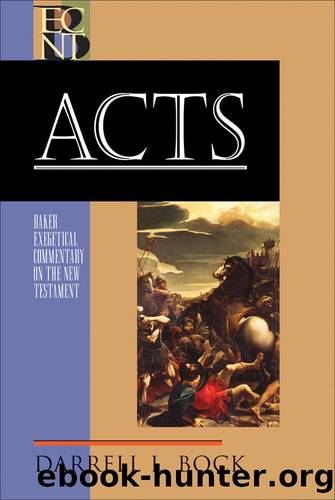Acts (Baker Exegetical Commentary on the New Testament) by Darrell L. Bock

Author:Darrell L. Bock [Bock, Darrell L.]
Language: eng
Format: azw3
Tags: REL006000, REL006070, REL006100
ISBN: 9781441200266
Publisher: Baker Publishing Group
Published: 2007-09-30T16:00:00+00:00
Additional Note
13:8. The Western text (D) reads a name here that means “ready” (ἑτοίμας, hetoimas), which might be equated with Atomos, a textual variant for the name of a Jewish magician (also called Simon) mentioned by Josephus in Ant. 20.7.2 §142. This is not well enough attested to be likely. The addition might seek to make a parallel with Simon Magus in Acts 8.
3. Paul and Barnabas in Pisidian Antioch (13:13–52)
This scene contains the most developed Pauline synagogue speech in Acts along with the reaction it generates. In Pisidian Antioch of Asia Minor, Paul addresses the Jews about God’s promise. The address rehearses the history of Israel from its origin to David and then leaps over a thousand years to John the Baptist and Jesus.
The setting of the speech comes first (vv. 13–15), and then the survey of Israel’s history to the time of John (vv. 16–25). Next are the declaration about Jesus (vv. 26–37) and the application (vv. 38–41). So the speech itself has three basic sections, once the setting appears.
A second way to outline the speech is grounded in the kind of material being presented and divides it into five parts. The history (vv. 16–25) leads to the basic kerygma (vv. 26–30), as attested by witnesses (v. 31) and scriptural proof (vv. 32–37), so that a response of conversion is in order (vv. 38–41; Schneider 1982: 128–29).
The aftermath includes a follow-up speech on the next Sabbath in verses 42–47. The unit ends in vv. 48–52 with the impact of the speeches and the largely negative Jewish reaction, which leads to the missionary party’s departure from the city.
The major point of the progress of Paul’s ministry appears in verses 46–47: that Jewish rejection will not stop the mission as the message proceeds to the Gentiles, even though the promise was originally “for us” (so vv. 26, 30–33a).
The purpose is to declare how Jesus fulfilled promises made to David long ago, by giving a sample of Paul’s message in a synagogue. Thus the narrative is a speech in form and rooted in a Pauline source (Fitzmyer 1998: 507). This speech, Peter’s opening addresses in Acts 2–3, and Stephen’s speech in Acts 7 are the key speeches in Acts on Jewish promise. Paul’s speech here parallels another synagogue speech that Jesus gave in Luke 4:16–30, declaring fulfillment, after which he confronted the force of evil in the same chapter (Luke 4:16–44, but in reverse order, since Paul confronts in Acts 13:1–12 and then preaches here whereas Jesus preached in Luke 4:16–30 and then confronted in 4:31–44). The ministry of Jesus continues through Paul. Rejection also continues, but it will not stop the impact of this ministry, which is rooted in divine work and power. Witherington (1998: 403–4) suggests that Sergius Paulus may have suggested Pisidian Antioch as the next place to visit, given that he had family connections there.
Download
This site does not store any files on its server. We only index and link to content provided by other sites. Please contact the content providers to delete copyright contents if any and email us, we'll remove relevant links or contents immediately.
| Guides | New Testament |
| Old Testament |
The Five People You Meet in Heaven by Mitch Albom(3476)
The Secret Power of Speaking God's Word by Joyce Meyer(2980)
Real Sex by Lauren F. Winner(2968)
Name Book, The: Over 10,000 Names--Their Meanings, Origins, and Spiritual Significance by Astoria Dorothy(2940)
The Holy Spirit by Billy Graham(2894)
0041152001443424520 .pdf by Unknown(2785)
ESV Study Bible by Crossway(2733)
How The Mind Works by Steven Pinker(2732)
Ancient Worlds by Michael Scott(2627)
Churchill by Paul Johnson(2510)
The Meaning of the Library by unknow(2508)
The ESV Study Bible by Crossway Bibles(2504)
The Gnostic Gospels by Pagels Elaine(2472)
MOSES THE EGYPTIAN by Jan Assmann(2374)
Jesus by Paul Johnson(2312)
City of Stairs by Robert Jackson Bennett(2309)
The Complete Dead Sea Scrolls in English (7th Edition) (Penguin Classics) by Geza Vermes(2237)
Ancient Near Eastern Thought and the Old Testament by John H. Walton(2196)
The Nativity by Geza Vermes(2181)
